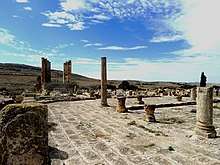Althiburos
Coordinates: 35°52′24″N 8°47′13″E / 35.873444°N 8.786861°E

Althiburos is a Tunisian archaeological site located in the governorate of Kef, more precisely in the Dahmani delegation,[1][2] ~9 kilometres (5.6 mi) southwest of the town of Medeina, on the Mt. Ouartane plateau.[3]
Location
Althiburos, was at the border with Numidia, at the confluence of the Oum-el-Abid and the Medeine Rivers in the village of Fej El Tamar.[4]
The city of was originally Berber and a Punic inscription was found there (now at the Louvre Museum), fell under the influence of Carthage, and then to Rome. It was a municipality in the second century under Adrià (Municipium Aelium Hadrianum Augustum Althiburitanum ) and later obtained the Italian law.[5] It was the seat of a Christian bishop from the 4th century to the 7th century and later disappeared, and under the Arabs a new population emerged in Ebba Ksour, on the plain. The site was kept intact and was discovered by travelers in the 18th century.
History


An ancient Numidian city passed under the influence of Carthage, located on the road linking Carthage to Theveste, the city obtained the status of municipality under the name of Municipium Aelium Hadrianum Augustum Althiburitanum[6] from Emperor Hadrian (117-138).
It was prosperous in the 2nd and 3rd centuries, then the seat of a Christian bishopric in the 4th-7th centuries, after which the city was deserted by its inhabitants who moved to Ebba Ksour.
Archaeology
Apart from travel stories that describe it, the site has seen few archaeological excavations. Excavations begun in 1908, interrupted and resumed in 1912, reveal part of the forum, a main street and a monumental door to a bay, with an inscription dedicated to Hadrian.[7][8]
Under the aegis of the National Heritage Institute of Tunisia, Spanish and Italian teams have been conducting excavation projects since 2006-2007.[9]
The main sites are:
- Capitolium and Forum (44.6 by 37.15 meters (146.3 ft × 121.9 ft)) on a paved esplanade (23.35 by 30.8 meters (76.6 ft × 101.0 ft)) surrounded by a porch with 10 x 12 columns.
- A statue of Minerva and one of Juno in marble were found.
- A triumphal arch is mostly in ruins, but the façade is partly conserved. It was excavated in 1912 and dated between 185 and 191.
- There is a second temple (dedicated to an unknown god or gods) on the opposite side of the Forum, of which only the podium and some Corinthian architectural elements remain; From an inscription, it seems datable to 145. In the northeast corner there is a complex of buildings including a house with a peristyle of 16 columns and geometric mosaics on the four porticos; Other mosaics are in the Bardo Museum. To the southeast of the square, a 10 x 7 meter building that was probably a factory and a monumental fountain
- The house of the Muses, with outstanding mosaics.
- The house of the Peixos scene, on the other side of the river Oued Oum El Abid, with mosaics representing scenes of fish.
- Triumphal arch of the 4th or 5th century
- House of Asclepius, named after a mosaic, had functions that could not be determined, but it is quite original. The mosaics are of great quality
- House of the sixteen bases, by the sixteen figures that appear in six stones of the base that seem to show Punic influence.
- Theater, dam, Mausoleums, the main one of Ksar Ben Hannoun, to the west with a cell of 3.2 by 2.5 meters (10.5 ft × 8.2 ft) and an inscription.
- The Roman Road to Tebessa.
Theater

The Roman Theatre is located on top of a hill. Remains partially buried remain in the middle of scattered blocks only a series of 19 arcades of which only go beyond the top, surmounted by five arcades of the first floor. René Cagnat and Henri Saladin at the end of the 19th century gave the following dimensions for this theater: 60 meters (200 ft) in diameter and 35 meters (115 ft) in width. The archaeological activities carried out since 2007 have as objective the survey of the ruins and the reconstruction of the theater.[10][11]
See Also
References
- ↑ Mongi Ennaïfer, « La cité d'Althiburos et l'édifice des Asclepieia », Bibliothèque archéologique, vol. 1, éd. Institut national d'archéologie et d'art, Tunis, 1976
- ↑ "Web d'una excavació arqueològica a Althiburos (2007)". Archived from the original on 2011-01-21. Retrieved 2017-08-14.
- ↑ Richard Stillwell, The Princeton Encyclopedia of Classical Sites (Princeton University Press, 14 Mar. 2017) p44.
- ↑ Richard Stillwell, William L. MacDonald, Marian Holland McAllister, Stillwell, Richard, MacDonald, William L., McAlister, Marian Holland, Ed., ALTHIBUROS, The Princeton Encyclopedia of Classical Sites.
- ↑ A. Merlin, “Forum et maisons d'Althiburos,” Notes et Documents, VI (1913).
- ↑ Alfred Merlin, « Fouilles à Althiburos (Medeina) », CRAI, vol. 56, no 6, (1912), p.420
- ↑ http://db.edcs.eu/epigr/epi_einzel.php?s_sprache=fr&p_belegstelle=CIL+08%2C+01825&r_sortierung=Belegstelle
- ↑ Alfred Merlin, « Fouilles à Althiburos (Medeina) », CRAI, vol. 56, no 6, 1912, p. 418.
- ↑ http://www.kapitalis.com/culture/42-arts/1971-tunisie-la-cite-dalthiburos-sort-de-terre.html
- ↑ René Cagnat & Henri Saladin, « Voyage en Tunisie », Tour du monde, éd. Hachette, Paris, 1887, n° 1, p. 242.
- ↑ Jean-Claude Lachaux, Théâtres et amphithéâtres d'Afrique proconsulaire, éd. Édisud, Aix-en-Provence, 1969, p. 33.